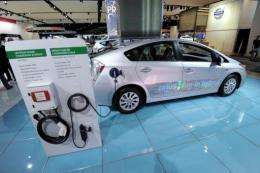Electric drive vehicles have little impact on US pollutant emissions, study finds

(Phys.org) —A new study from North Carolina State University indicates that even a sharp increase in the use of electric drive passenger vehicles (EDVs) by 2050 would not significantly reduce emissions of high-profile air pollutants carbon dioxide, sulfur dioxide or nitrogen oxides.
"EDVs" is a catch-all term that includes hybrid, plug-in hybrid and battery electric vehicles.
"We wanted to see how important EDVs may be over the next 40 years in terms of their ability to reduce emissions," says Dr. Joseph DeCarolis, an assistant professor of civil, construction and environmental engineering at NC State and senior author of a paper on the new model. "We found that increasing the use of EDVs is not an effective way to produce large emissions reductions."
The researchers ran 108 different scenarios in a powerful energy systems model to determine the impact of EDV use on emissions between now and 2050. They found that, even if EDVs made up 42 percent of passenger vehicles in the U.S., there would be little or no reduction in the emission of key air pollutants.
"There are a number of reasons for this," DeCarolis says. "In part, it's because some of the benefits of EDVs are wiped out by higher emissions from power plants. Another factor is that passenger vehicles make up a relatively small share of total emissions, limiting the potential impact of EDVs in the first place. For example, passenger vehicles make up only 20 percent of carbon dioxide emissions.
"From a policy standpoint, this study tells us that it makes more sense to set emissions reductions goals, rather than promoting specific vehicle technologies with the idea that they'll solve the problem on their own."
The energy systems model also showed that key factors in encouraging use of EDVs are oil price and battery cost. If batteries are cheap and oil is expensive, EDVs become more attractive to consumers. "That's consistent with results from other studies," DeCarolis says.
The paper, "How Much Do Electric Drive Vehicles Matter to Future U.S. Emissions?," is published online in Environmental Science & Technology. Lead author of the paper is Samaneh Babaee, a Ph.D. student at NC State. The paper was co-authored by Dr. Ajay Nagpure, a former postdoctoral researcher at NC State who is now at the University of Minnesota. The research was supported by National Science Foundation grant CBET-0853766.
More information: "How Much Do Electric Drive Vehicles Matter to Future U.S. Emissions?" Published: online January 2014 in Environmental Science & Technology pubs.acs.org/doi/abs/10.1021/es4045677
Abstract
Hybrid, plug-in hybrid, and battery electric vehicles—known collectively as electric drive vehicles (EDVs)—may represent a clean and affordable option to meet growing U.S. light duty vehicle (LDV) demand. The goal of this study is twofold: identify the conditions under which EDVs achieve high LDV market penetration in the U.S. and quantify the associated change in CO2, SO2, and NOX emissions through mid-century. We employ the Integrated MARKAL-EFOM System (TIMES), a bottom-up energy system model, along with a U.S. dataset developed for this analysis. To characterize EDV deployment through 2050, varying assumptions related to crude oil and natural gas prices, a CO2 policy, a federal renewable portfolio standard, and vehicle battery cost were combined to form 108 different scenarios. Across these scenarios, oil prices and battery cost have the biggest effect on EDV deployment. The model results do not demonstrate a clear and consistent trend towards lower system-wide emissions as EDV deployment increases. In addition to the tradeoff between lower tailpipe and higher electric sector emissions associated with plug-in vehicles, the scenarios produce system-wide emissions effects that often mask the effect of EDV deployment.
Journal information: Environmental Science & Technology
Provided by North Carolina State University



















